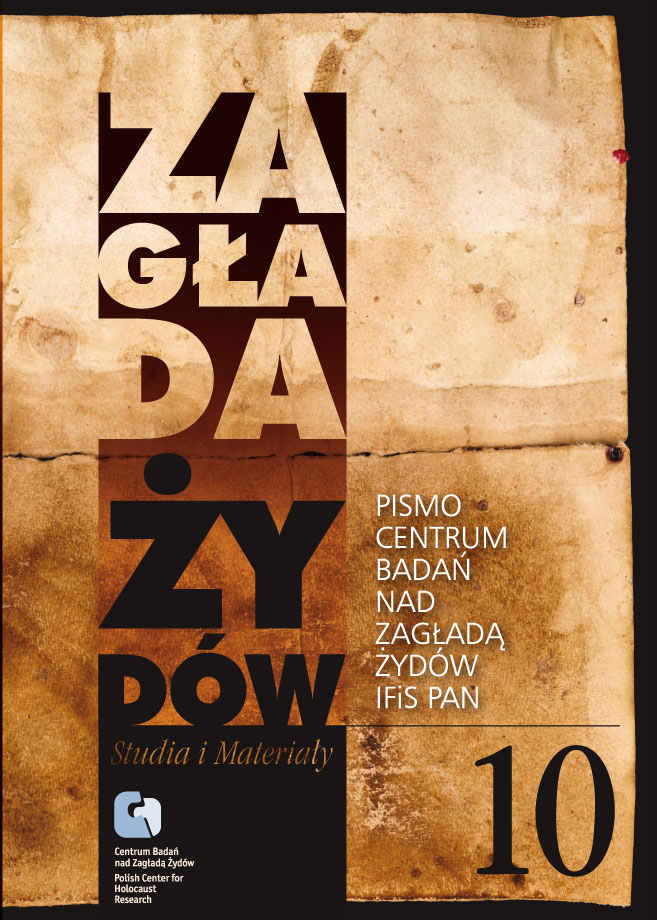Krzesiny i Kreising – między pamiętaniem a pomijaniem. Polskie miasteczko wobec historii, pamięci i rywalizacji w cierpieniu
Zagłada Żydów. Studia i Materiały, Nr 10 (2014), Strony: 443-461
Data zgłoszenia: 2020-10-22Data publikacji: 2014-12-01
 https://doi.org/10.32927/ZZSiM.532
https://doi.org/10.32927/ZZSiM.532
Abstrakt
The area around Krzesiny, located near the city of Poznań, Poland, witnessed several dark events during World War II: Germans oppressed the local population, culminating in a terrorizing action dubbed “akcja krzesińska;” also, a forced labor camp, named “Kreising,” was built near the township, housing mainly Jews. After the war, the suffering in Krzesiny was remembered, but selectively – “akcja” and other forms of Polish suffering were commemorated, while the camp was not. By exploring the “lieux de mémoire” in Krzesiny – dynamics of memory in a small township in Poland – this paper uses localized research to address the issue of gaps in collective memory and commemoration. We briefly look at the relevant history, Polish memory regarding wartime events in Krzesiny, and the postwar dynamics of collective memory. Discussing the latter, we identify a new phenomenon at work, one which we dub “collective disregard” – group neglect of the past of the “Other” that occurs without clear intent. We argue that “collective disregard” is an issue that naturally occurs in the dynamics of memory. By making a deliberate investment in balanced remembrance and commemoration, societies can counter the tendencies of “disregard” and curb the controversies of competitive victimization claims, also called “competitive martyrdom”.
Licencja
Prawa autorskie (c) 2014 Autor&"Zagłada Żydów. Studia i Materiały"

Utwór dostępny jest na licencji Creative Commons Uznanie autorstwa 4.0 Międzynarodowe.
https://creativecommons.org/licenses/by/4.0
Czasopismo publikowane jest w standardzie Diamond Open Access na licencji CC-BY-4.0 Deed - Uznanie autorstwa 4.0 Międzynarodowa - Creative Commons
Podobne artykuły
- Justyna Kowalska-Leder, Recenzja: Reprezentacje Zagłady w kulturze polskiej (1939–2019). Problematyka Zagłady w sztukach wizualnych i popkulturze, t. 1–2, red. Sławomir Buryła, Dorota Krawczyńska, Jacek Leociak, Warszawa: Wydawnictwo IBL PAN, 2021, 672 s. , Zagłada Żydów. Studia i Materiały: Nr 18 (2022)
- Agnieszka Haska, „Na tej fabryce nie pracują Żydzi”. Nieznana historia pomocy , Zagłada Żydów. Studia i Materiały: Nr 19 (2023)
- Nawojka Cieślińska-Lobkowicz, Nowe Muzeum Holocaustu w Amsterdamie , Zagłada Żydów. Studia i Materiały: Nr 20 (2024)
- Romuald Jakub Weksler-Waszkinel, Father Stanisław Musiał's Struggle with Memory , Zagłada Żydów. Studia i Materiały: 2008: Holocaust Studies and Materials
- Gabriel Finder, Proces Szepsla Rotholca a polityka kary w następstwie Zagłady , Zagłada Żydów. Studia i Materiały: Nr 2 (2006)
- Sławomir Buryła, A. Ubertowska, Świadectwo – trauma – głos. Literackie reprezentacje Holokaustu , Zagłada Żydów. Studia i Materiały: Nr 4 (2008)
- Maria Ferenc-Piotrowska, „Czarna, ogromna chmura wisi nad nami i na pewno spadnie…” Żydzi w miastach i miasteczkach Generalnego Gubernatorstwa wobec wiadomości o akcji „Reinhardt” , Zagłada Żydów. Studia i Materiały: Nr 13 (2017)
- Mikołaj Grynberg, Samuel Willenberg in memoriam , Zagłada Żydów. Studia i Materiały: Nr 12 (2016)
- Nawojka Cieślińska-Lobkowicz, Centrum Dokumentacji Nazizmu w Monachium i obywatelska pamięć Niemiec , Zagłada Żydów. Studia i Materiały: Nr 12 (2016)
- Bartłomiej Krupa, Historia krytyczna i jej „gabinet cieni”. Historiografia polska wobec Zagłady 2003–2013 , Zagłada Żydów. Studia i Materiały: Nr 10 (2014)
<< < 1 2 3 4 5 6 7 8 9 10 11 12 13 14 15 16 17 18 19 20 21 22 23 24 25 26 27 28 29 30 31 32 33 34 > >>
Możesz również Rozpocznij zaawansowane wyszukiwanie podobieństw dla tego artykułu.
 English
English
 Język Polski
Język Polski




